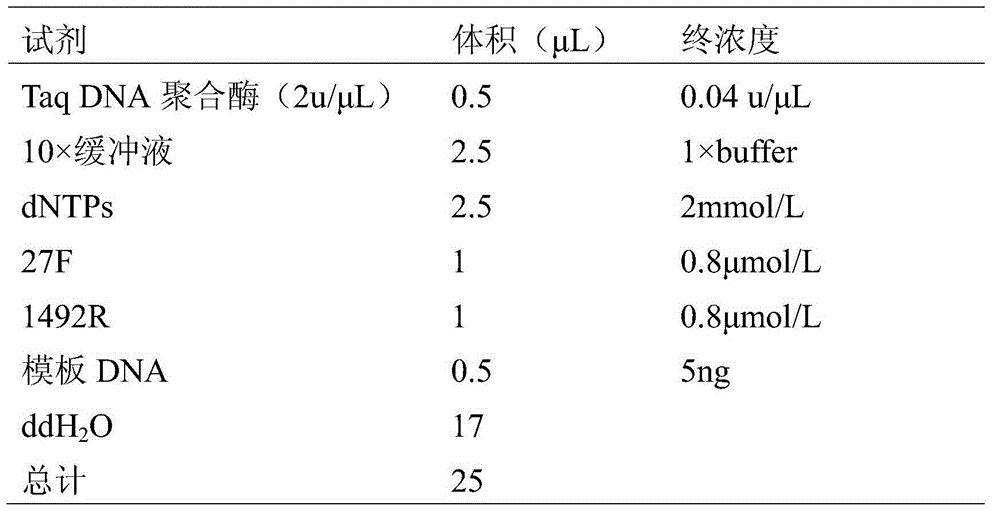Microbacterium sp. strain and application thereof
A technology of microbacteria and strains, applied in the field of microorganisms, can solve the problems of long cycle, low economy, low tolerance of high-concentration phenol-containing wastewater, etc.
- Summary
- Abstract
- Description
- Claims
- Application Information
AI Technical Summary
Problems solved by technology
Method used
Image
Examples
Embodiment 1
[0023] (1) It is obtained from the activated sludge of a biochemical aerobic pool of a petrochemical plant in Liaoning by enrichment culture method, and the specific steps are as follows.
[0024] (1) Preparation of culture medium: 100 mL of phenol-inorganic salt medium mixed system was placed in a 250 mL Erlenmeyer flask, including culture medium solution, inorganic salt trace element solution and phenol. Add 1mL trace element solution per 1L of culture medium; phenol is first dissolved in a water bath at 45°C, and added to the system after autoclaving the inorganic salt culture medium.
[0025] Medium solution (g / L): 0.9KH 2 PO 4 , 6.5Na 2 HPO 4 12H 2 O, 0.4 (NH 4 ) 2 SO 4 , 0.2MgSO 4 ·7H 2 O; trace element solution (g / L): 1g FeSO 4 ·7H 2 O, 1g MnSO 4 ·H 2 O, 0.25g Na 2 MoO 4 2H 2 O, 0.1g H 3 BO 4 , 0.25g CuCl 2 2H 2 O, 0.25g ZnCl 2 , 0.1gNH 4 ·VO 3 , 0.25g Co(NO 3 ) 2 ·6H 2 O, 0.1g NiSO 4 ·6H 2 O, dissolved in 900 mL of distilled water, added 5 m...
Embodiment 2
[0044] At pH 7.0, temperature 30°C, initial concentrations of phenol were 500mg / L, 1000mg / L, 1500mg / L, 2000mg / L, 2500mg / L, 3000mg / L, 3500mg / L, 4000mg / L, SY-PD The culture of the -42 strain was inoculated in 100 mL of the above-mentioned inorganic salt medium with phenol as the sole carbon source, cultured with shaking at 150 r / min for 48 hours, and then sampled.
[0045] The content of residual phenol in the sample was determined by 4-aminoantipyrine extraction spectrophotometry, and the degradation rate was calculated. Taking the initial concentration of phenol as the abscissa, taking the phenol degradation rate and OD600 value (cell concentration) as the ordinate, draw the degradation and cell concentration curves, and the results are shown in figure 1 .
[0046] from figure 1 It can be seen that Microbacterium SY-PD-42 strain has a good degradation effect on phenol when the phenol concentration is lower than 2000mg / L, and the degradation rate can reach more than 99%. Wel...
Embodiment 3
[0050] The culture of Microbacterium SY-PD-42 strain was inoculated in 100 mL of the above-mentioned inorganic salt medium with phenol as the sole carbon source, the pH of the medium was 7.0, and the initial concentration of phenol was 2000 mg / L. Min shaking culture, sampling every 6h.
[0051] Using 4-aminoantipyrine extraction spectrophotometry, measure the residual phenol content in the sample, take time as the abscissa, and the phenol residual concentration as the ordinate, draw the degradation curve, and the results are shown in figure 2 . from figure 2 It can be seen that when the initial phenol concentration of the medium is 2000mg / L, the Microbacterium SY-PD-42 bacterial strain of the present invention can degrade more than 99% of the phenol in the medium within 48h, and the final phenol concentration in the culture solution is lower than 1mg / L .
[0052] The Microbacterium strain SY-PD-42 of the present invention can be used to treat phenol-containing solutions t...
PUM
| Property | Measurement | Unit |
|---|---|---|
| tolerance concentration | aaaaa | aaaaa |
Abstract
Description
Claims
Application Information
 Login to View More
Login to View More - R&D
- Intellectual Property
- Life Sciences
- Materials
- Tech Scout
- Unparalleled Data Quality
- Higher Quality Content
- 60% Fewer Hallucinations
Browse by: Latest US Patents, China's latest patents, Technical Efficacy Thesaurus, Application Domain, Technology Topic, Popular Technical Reports.
© 2025 PatSnap. All rights reserved.Legal|Privacy policy|Modern Slavery Act Transparency Statement|Sitemap|About US| Contact US: help@patsnap.com



